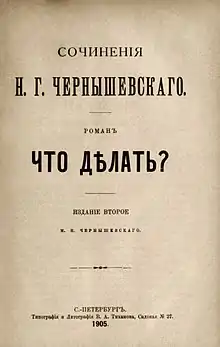What Is to Be Done? (novel)
What Is to Be Done? (Russian: Что делать?, tr. Chto délat'?, lit. 'What to Do?') is an 1863 novel written by Russian philosopher, journalist, and literary critic Nikolai Chernyshevsky, written in response to Fathers and Sons (1862) by Ivan Turgenev. The chief character is Vera Pavlovna, a woman who escapes the control of her family and an arranged marriage to seek economic independence.
 1905 title page | |
| Author | Nikolai Chernyshevsky |
|---|---|
| Original title | Chto délat'? |
| Country | Russian Empire |
| Language | Russian |
| Genre | Novel |
Publication date | 1863 |
Published in English | 1886 |
| Media type | Print (hardback and paperback) |
The novel advocates the creation of small socialist cooperatives based on the Russian peasant commune, but one that is oriented toward industrial production. The author promoted the idea that the intellectual's duty was to educate and lead the laboring masses in Russia along a path to socialism that bypassed capitalism. The book's framework takes place through a story of a privileged couple who decide to work for the revolution and ruthlessly subordinate everything in their lives to the cause. As such, the work furnished a blueprint for the asceticism and dedication unto death that became an ideal of the early socialist underground of the Russian Empire. Despite his minor role, Rakhmetov, one of the characters in the novel, became an emblem of the philosophical materialism and nobility of Russian radicalism. Through one character's dream, the novel also expresses a society gaining "eternal joy" of an earthly kind.
When he wrote the novel, Chernyshevsky was himself imprisoned in the Peter and Paul fortress of St. Petersburg and was to spend years in Siberia. He asked and received permission to write the novel in prison; the authorities passed the manuscript along to the newspaper Sovremennik, his former employer which also approved it for publication in installments in its pages.
What Is to Be Done? has been called "a handbook of radicalism,"[1] and led to the founding of the Land and Liberty society.[2] It inspired several generations of revolutionaries in Russia, including populists, nihilists, and Marxists. Likewise, Vladimir Lenin, Georgi Plekhanov, Peter Kropotkin, Alexandra Kollontay, Rosa Luxemburg, and Swedish writer August Strindberg[3] were all highly impressed with the book, and it came to be officially regarded as a Russian classic in the Soviet period.[4][5]
Reactions
More than the novel itself, the book is perhaps best known in the English-speaking world for the response it garnered.
Fyodor Dostoevsky mocked the utilitarianism and utopianism of the novel in his 1864 novella Notes from Underground, as well as in his 1872 novel Demons. Leo Tolstoy wrote his own What Is to Be Done?, published in 1886, based on his own ideas of moral responsibility.[6]
It was Vladimir Lenin who found Chernyshevsky's work inspiring, and is said to have read the book five times in one summer; Lenin would name his 1902 pamphlet What Is to Be Done? as a result. He also took great influence personally as well as politically, modelling himself somewhat on the protagonist. According to Joseph Frank, Professor Emeritus of Slavic and Comparative Literature at Stanford University, "Chernyshevsky's novel, far more than Marx's Capital, supplied the emotional dynamic that eventually went to make the Russian Revolution."[7]
Interesting facts
In the 4th dream of Vera Pavlovna, the novel mentions aluminium as the "metal of the future." However, aluminium became widely used only beginning with World War I in 1914. The "Dame in mourning" appearing at the end of the novel is Olga S. Chernyshevskaya, the author's wife.
In other works
- Characters with the last name Kirsanov also appear in Ivan Turgenev's Fathers and Sons.
- In Notes from Underground, Fyodor Dostoyevsky argues with Nikolai Chernyshevsky's ideas. In particular, he responds negatively to Chernyshevsky's idealization of The Crystal Palace, a theme which is referenced throughout Russian literature.
- American playwright Tony Kushner references the book multiple times in his play Slavs!.
- The titular character of André Gide's Les caves du Vatican (Lafcadio's Adventures) resembles Rakhmetov.
- In the book Ayn Rand: The Russian Radical, author Chris Matthew Sciabarra claims that What Is to Be Done? is one of the sources of inspiration for Rand's thought.[8] For example, the book's main character, Lopuhov, says: "I am not a man to make sacrifices. And indeed there are no such things. One acts in the way that one finds most pleasant."
- Vladimir Nabokov's final novel in Russian The Gift ridicules What Is to Be Done? in its fourth chapter.
References
- Marder, Jen, Mike Meyer, and Fred Wyshak. 1996. "Dostoevsky's 'Notes from Underground': A Study Guide." Dostoevsky [RU 351]. Middlebury College.
- "Nikolai Gavrilovich Chernishevsky | The Philosophers who Influenced Dostoevsky." Dostoevsky in Translation [Russian 360]. Atlanta, GA: Emory University. Archived from the original 24 July 2011.
- Myrdal, Jan. 1986. Ord och avsikt.
- Chernets, L. V. (1990). "Н. Г.: Биобиблиографическая справка". Русские писатели. Биобиблиографический словарь. Том 2. М--Я. Под редакцией П. А. Николаева. М., "Просвещение". Retrieved 1 March 2012.
- Plekhanov, Georgi (1910). "Н.Г.Чернышевский". Библиотека научного социализма. Т.4. Retrieved 1 March 2012.
- "What Is to Be Done?".
- Amis, Martin (2002). Koba the Dread. Miramax. p. 27. ISBN 0-7868-6876-7.
- Sciabarra, Chris Matthew (1 November 2010). Ayn Rand: The Russian Radical. Penn State Press. p. 28. ISBN 0-271-04236-2.
Further reading
| Wikisource has original text related to this article: |
- Mack, Maynard. 1956. The Norton Anthology of World Masterpieces. pp. 1,085–1,086.
External links
- What Is to Be Done?. Russian text.
- What Is to Be Done?. 1886 English translation.